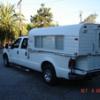Phil
You will not find a bigger proponent and advocate for personal responsibility and self-reliance than me. But, when poor decisions result in others being summoned and exposed to danger to save you is altogether a different matter.
I submit it is better to perform a straight-line pull forward to clear the obstacle and turn around. If that is not feasible, then perhaps it is time to seek an additional recovery vehicle.
Needing a winch on the rear of your truck puts you in the less than 1% of 1% who venture into areas where you would need self extraction with a rear winch. Further, you are almost committed to a straight-line pull with a rear winch since you can't turn the rear wheels. Off-line pulls are manageable, but, put tremendous stress on the winch and the vehicle. Not to mention less winching power with off-line pulls. Further winch bumpers are not designed to take asymmetric loading when you start winching 10-20 degrees off-line.
I doubt any of us here have the overlanding experience level of the Wescott's. And I recall Gary once being asked why he didn't have a rear winch. And his comment was if he needed a rear winch, he made a poor decision much, much earlier.
My Warn 16.5S is probably my 12th Warn winch. Warn does not recommend exceeding the length of their wiring harness due to voltage drop. I incorrectly stated amps in my earlier post, the issue is voltage drop in longer wire runs.
You can only achieve max rated pull of the winch when you are on the last 10 wraps or so on the drum. Further, you only achieve max rated voltage of the winch's motor when you use the Warn electrical harness. Exceed that length with 2 GA wire and you will have voltage drop.
A winch is just another tool in the proverbial tool bag. But a tool that takes many overlanders down the poor decision-making path simply because they have a winch. Or worse, get hurt, hurt some else or damage equipment because of a lack of knowledge and experience. Winching is inherently very dangerous and ALL safety precautions MUST be adhered too. No shortcuts. And, no tool will overcome poor decision-making.
As a former military fighter pilot and retired airline captain, I do not believe sound risk management is aligned with poor decision making based on final outcome. Risk management and taking risks beyond what you can manage is not risk management.
Case in point...the Delta flight that flew from JFK to SJU Wednesday before Irma hit. Delta is playing that up in the media, but, nearly every professional airline pilot is calling it a stupid marketing ploy to risk that many souls. This was a horrible dispatch decision that far exceeded any airline's risk management program. Just because they safely completed the round trip flight without incident doesn't make the decision to go a good one.
And I absolutely agree, if there is any doubt, even the slightest, there is no doubt, turn around!
And winching can be safe and is a very effective tool to possess. But very unforgiving if not treated with the utmost respect.
Bill
Edited by Advmoto18, 08 September 2017 - 04:06 PM.

















